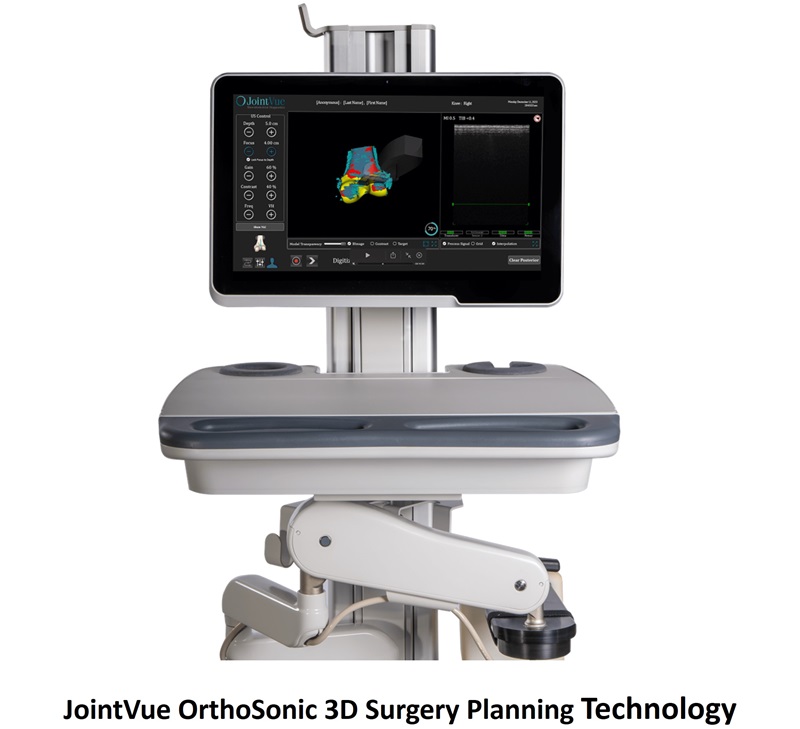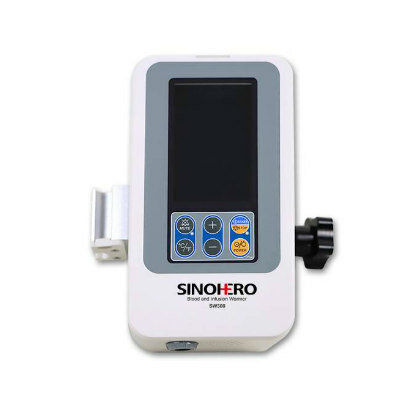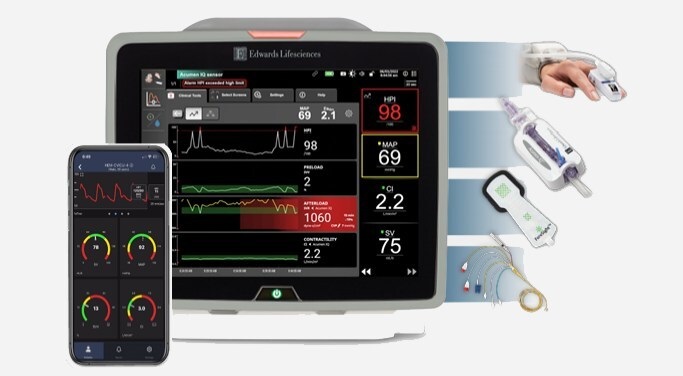AI Diagnostic Tool Guides Rapid Diagnosis and Prediction of Sepsis
|
By HospiMedica International staff writers Posted on 05 Apr 2024 |
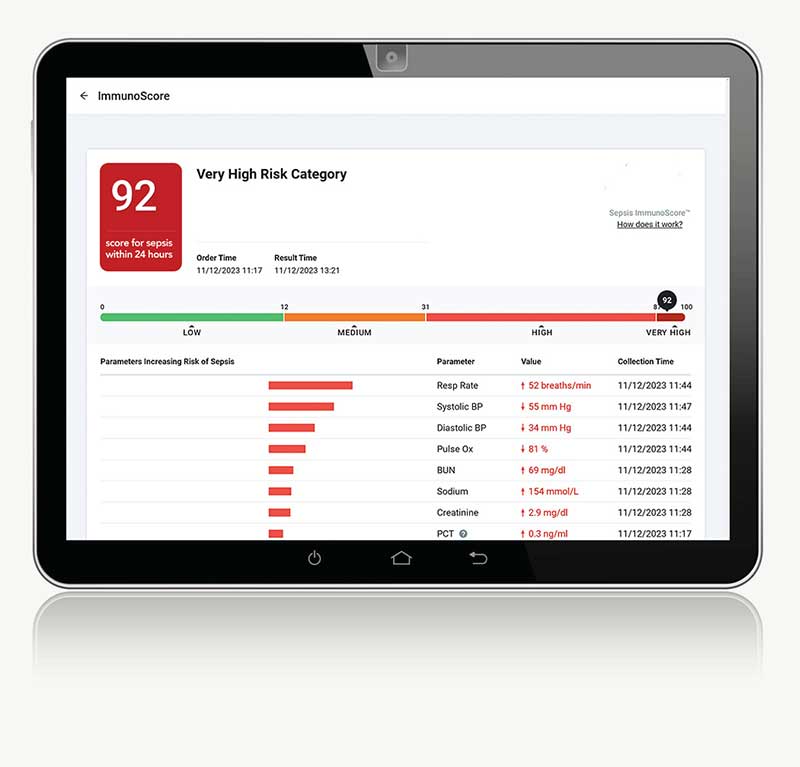
Sepsis, a condition marked by an excessive immune response to infection, presents a formidable diagnostic challenge, with significant implications for global health and healthcare budgets. Annually, sepsis is responsible for more fatalities than the combined total of all cancer types and huge expenses for healthcare systems. Sepsis survivors often endure severe, lasting impacts on their lives even after discharge. Now, a revolutionary artificial intelligence (AI) diagnostic and predictive tool for early sepsis detection has significant potential to save lives and reduce hospital length of stay.
The Sepsis ImmunoScore from Prenosis (Chicago, IL, USA) is an AI software as a medical device (AI SaMD) for guiding the rapid diagnosis and prediction of sepsis. It assesses the risk of sepsis onset or progression within 24 hours following a patient's evaluation in emergency or hospital settings. By analyzing a comprehensive array of 22 biomarkers and clinical data points, the Sepsis ImmunoScore evaluates the patient's overall biological state, providing a risk score and categorizing patients into four distinct risk levels. These classifications are indicative of potential clinical outcomes, such as hospital stay duration, mortality risk, and the necessity for escalated care measures like ICU admission, mechanical ventilation, or vasopressor administration within the next 24 hours.
By integrating seamlessly into hospital electronic health records (EHRs), Sepsis ImmunoScore’s software becomes easily accessible to clinicians. It features a user-friendly interface that details the contribution of each parameter to the overall sepsis risk assessment, fostering a transparent relationship between clinicians and the AI tool. This transparency is crucial for encouraging rapid and informed clinical decisions, thereby enhancing patient care quality and hospital efficiency. The Sepsis ImmunoScore was built using the Immunix precision medicine platform from Prenosis which is designed to advance personalized medicine in acute care settings. The U.S. Food and Drug Administration (FDA) has granted marketing authorization for the Sepsis ImmunoScore using the De Novo pathway, making it the first-ever AI sepsis diagnostic to be granted marketing authorization by the FDA.
"FDA authorization of a sepsis diagnostic tool with significant predictive power is a landmark event for people that could ever be at risk of sepsis at some point in their lives," said Bobby Reddy, Jr, Ph.D., Prenosis Co-Founder and CEO. "Until now, there was no other FDA authorized AI diagnostic for sepsis, which is why the Sepsis ImmunoScore had to be granted marketing authorization through the De Novo pathway. FDA authorization offers yet another important piece of evidence of the potential of the Sepsis ImmunoScore to improve care."
Latest Critical Care News
- Cutting-Edge Bioelectronic Device Offers Drug-Free Approach to Managing Bacterial Infections
- Early TAVR Benefits Patients with Asymptomatic Severe Aortic Stenosis
- Sophisticated Machine-Learning Approach Uses Patient EHRs to Predict Pneumonia Outcomes
- First-Of-Its-Kind Experimental Therapy Enhances Tissue Repair After Heart Attack
- AI Model Predicts Patients at Most Risk of Complication During Treatment for Advanced Kidney Failure
- AI Model Predicts Patients’ Risk of Developing and Worsening Disease from ECGs
- Grain-Sized Soft Robots Controlled by Magnetic Fields Deliver Medical Drugs

- AI Tool Helps Identify Heart Failure Risk in Diabetes Patients
- Inflammation Reducing Antibody Could Serve as Cardio-Immunotherapy for Heart Failure Patients
- AI Tool Accurately Identifies Patients Who Could Require Emergency Hospital Admission
- Simple Risk Score Model Helps Wean Patients from Mechanical Circulatory Support
- AI-Powered Wearable Camera System Detects Errors in Medication Delivery

- Re-Engineered Immune Cells Penetrate and Kill Solid Tumors
- New Nanoparticle Nanotherapy Infusion Cleans Arteries
- Fluorescence Imaging a Game-Changer for Bedside Biofilm Detection
- Spongelike Bandage with Antimicrobial Efficacy Stops Hemorrhaging and Mitigates Risk of Infection

Channels
Surgical Techniques
view channel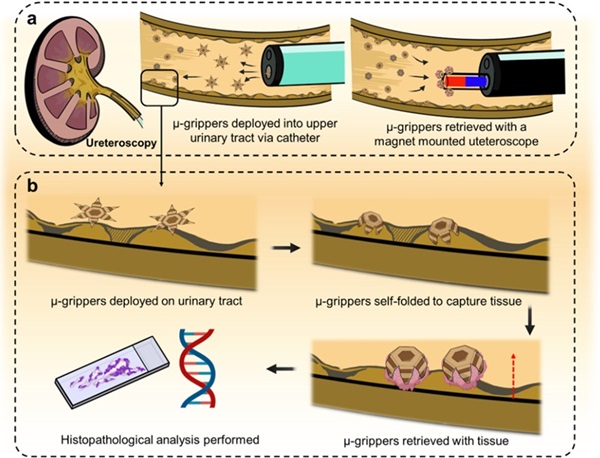
Microgrippers For Miniature Biopsies to Create New Cancer Diagnostic Screening Paradigm
The standard diagnosis of upper urinary tract cancers typically involves the removal of suspicious tissue using forceps, a procedure that is technically challenging and samples only a single region of the organ.... Read moreMiniature Soft Lithium-Ion Battery Could Be Used as Defibrillator During Surgery
The development of tiny smart devices, measuring just a few cubic millimeters, requires equally miniature power sources. For minimally invasive biomedical devices that interact with biological tissues,... Read more.jpg)
TAVI Procedure Supported by Radial Artery Access Reduces Bleeding Complications
The TAVI procedure, or Transcatheter Aortic Valve Implantation, is a minimally invasive technique in which a new aortic valve is inserted through a femoral artery to replace a narrowed old valve.... Read more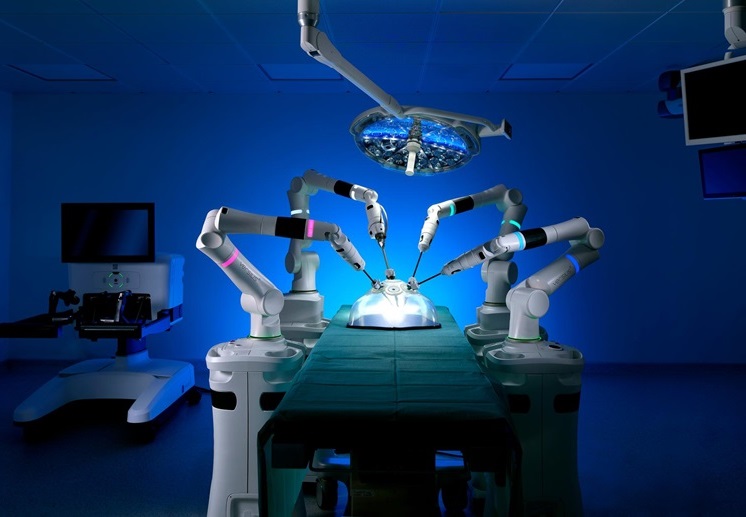
Portable Surgical Robot Seamlessly Integrates into Any OR for Performing Cholecystectomy Procedures
The United States represents a significant market with a strong demand for a flexible surgical robotic system applicable across various care settings. However, there has been a lack of sufficient options... Read morePatient Care
view channel
Portable Biosensor Platform to Reduce Hospital-Acquired Infections
Approximately 4 million patients in the European Union acquire healthcare-associated infections (HAIs) or nosocomial infections each year, with around 37,000 deaths directly resulting from these infections,... Read moreFirst-Of-Its-Kind Portable Germicidal Light Technology Disinfects High-Touch Clinical Surfaces in Seconds
Reducing healthcare-acquired infections (HAIs) remains a pressing issue within global healthcare systems. In the United States alone, 1.7 million patients contract HAIs annually, leading to approximately... Read more
Surgical Capacity Optimization Solution Helps Hospitals Boost OR Utilization
An innovative solution has the capability to transform surgical capacity utilization by targeting the root cause of surgical block time inefficiencies. Fujitsu Limited’s (Tokyo, Japan) Surgical Capacity... Read more
Game-Changing Innovation in Surgical Instrument Sterilization Significantly Improves OR Throughput
A groundbreaking innovation enables hospitals to significantly improve instrument processing time and throughput in operating rooms (ORs) and sterile processing departments. Turbett Surgical, Inc.... Read moreHealth IT
view channel
Machine Learning Model Improves Mortality Risk Prediction for Cardiac Surgery Patients
Machine learning algorithms have been deployed to create predictive models in various medical fields, with some demonstrating improved outcomes compared to their standard-of-care counterparts.... Read more
Strategic Collaboration to Develop and Integrate Generative AI into Healthcare
Top industry experts have underscored the immediate requirement for healthcare systems and hospitals to respond to severe cost and margin pressures. Close to half of U.S. hospitals ended 2022 in the red... Read more
AI-Enabled Operating Rooms Solution Helps Hospitals Maximize Utilization and Unlock Capacity
For healthcare organizations, optimizing operating room (OR) utilization during prime time hours is a complex challenge. Surgeons and clinics face difficulties in finding available slots for booking cases,... Read more
AI Predicts Pancreatic Cancer Three Years before Diagnosis from Patients’ Medical Records
Screening for common cancers like breast, cervix, and prostate cancer relies on relatively simple and highly effective techniques, such as mammograms, Pap smears, and blood tests. These methods have revolutionized... Read morePoint of Care
view channel
Handheld, Sound-Based Diagnostic System Delivers Bedside Blood Test Results in An Hour
Patients who go to a doctor for a blood test often have to contend with a needle and syringe, followed by a long wait—sometimes hours or even days—for lab results. Scientists have been working hard to... Read more
Smartphone-Enabled, Paper-Based Quantitative Diagnostic Platform Transforms POC Testing
Point-of-care diagnostics are crucial for public health, offering rapid, on-site testing that enables prompt diagnosis and treatment. This is especially valuable in remote or underserved regions where... Read moreBusiness
view channel
Hologic Acquires Gynesonics to Strengthen Existing Gynecological Surgical Business
Hologic (Marlborough, MA, USA) has signed a definitive agreement to acquire Gynesonics (Redwood City, CA, USA) for approximately USD 350 million, subject to working capital and other customary closing adjustments.... Read more